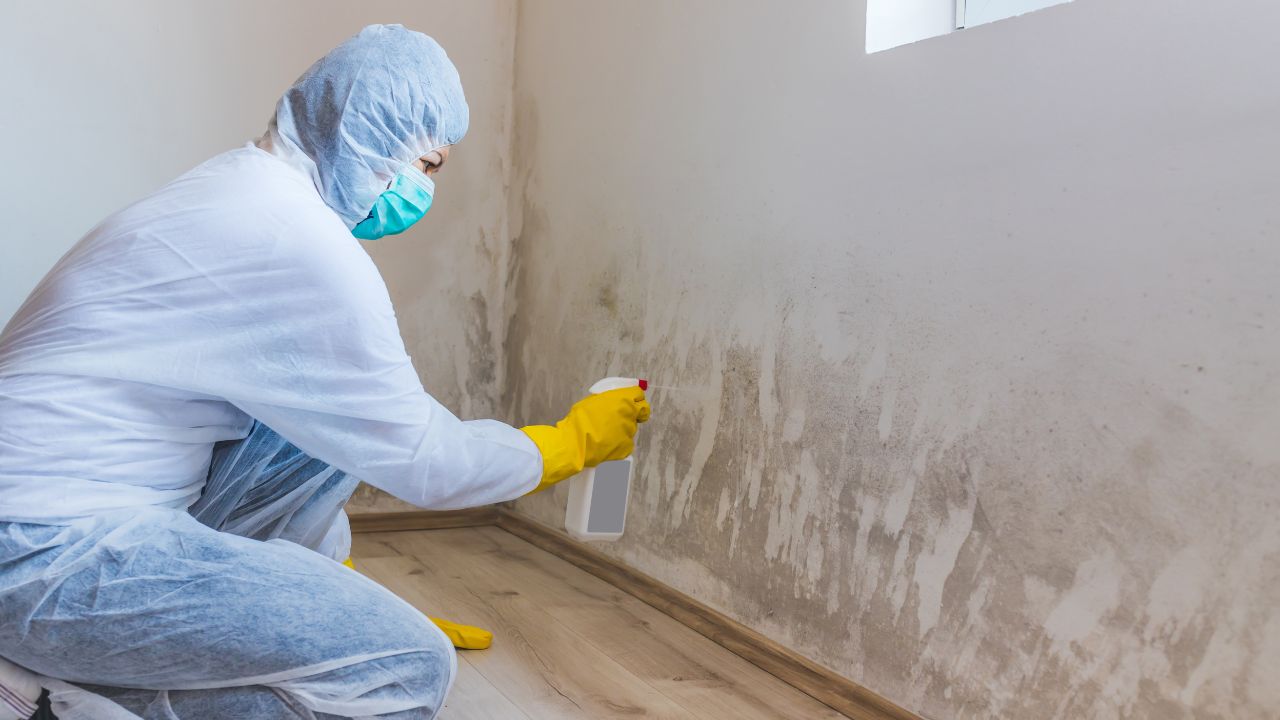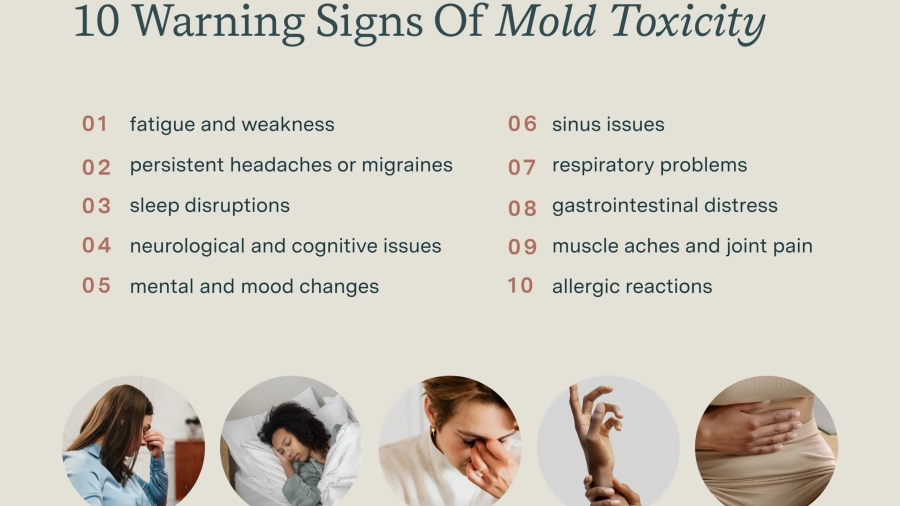Introduction
10 warning signs of mold toxicity, Mold is a natural part of our environment, but when it finds its way into our living spaces and goes unchecked, it can pose serious health risks. Mold toxicity, or mycotoxicosis, occurs when individuals are exposed to high levels of mold and its toxins, leading to a range of health problems. The insidious nature of mold toxicity lies in its ability to manifest with vague and varied symptoms, often mimicking other health issues. In this article, we will delve into the 10 warning signs of mold toxicity, shedding light on the importance of recognizing these symptoms for early intervention and prevention.

Respiratory Issues
One of the most common warning signs of mold toxicity is respiratory problems. Mold spores can be inhaled into the lungs, triggering respiratory symptoms such as coughing, wheezing, and shortness of breath. Individuals with mold toxicity may experience a persistent or worsening cough that doesn’t respond to conventional treatments. Asthmatic individuals may notice an exacerbation of their symptoms, including increased frequency and intensity of asthma attacks.
Must Read=Cymbalta ruined my life
Chronic exposure to mold can lead to the development of conditions such as allergic rhinitis or sinusitis, characterized by nasal congestion, sinus pressure, and postnasal drip. If respiratory symptoms persist despite efforts to address them, it’s crucial to consider the possibility of mold toxicity.
Fatigue and Weakness
Unexplained fatigue and weakness are often overlooked symptoms of mold toxicity. Individuals experiencing mold-related health issues may find themselves inexplicably tired, even after a full night’s sleep. This persistent fatigue can interfere with daily activities, leading to a decline in overall well-being and productivity.
Mold toxins, known as mycotoxins, can have systemic effects on the body, impacting energy levels and contributing to a sense of lethargy. Identifying the source of fatigue is essential, as mold toxicity can have far-reaching consequences if left untreated.
1:Cognitive Dysfunction
Mold toxicity can affect cognitive function, leading to difficulties with memory, concentration, and overall mental clarity. Individuals may experience “brain fog,” a term used to describe a hazy or confused mental state. This cognitive dysfunction can interfere with work, academic performance, and daily tasks, causing frustration and stress.
Persistent exposure to mycotoxins may contribute to neurological symptoms, and individuals with mold toxicity may report difficulty finding words, organizing thoughts, or processing information. Recognizing cognitive dysfunction as a potential warning sign of mold toxicity is crucial for early intervention and improved outcomes.
Joint and Muscle Pain
Chronic joint and muscle pain are often associated with mold toxicity. Mycotoxins can trigger inflammation in the body, leading to aches and pains that may be mistakenly attributed to other causes. Individuals may experience stiffness, discomfort, or pain in the joints and muscles without an apparent injury or inflammatory condition.
It’s important to distinguish between mold-related pain and other musculoskeletal issues. Persistent or unexplained pain should prompt individuals to consider environmental factors, including the possibility of mold exposure, as part of their overall health assessment.
1: Headaches and Migraines
Frequent headaches or migraines can be a warning sign of mold toxicity. Mold spores release volatile organic compounds (VOCs) that can be irritating to the respiratory system and trigger headaches in susceptible individuals. Additionally, mycotoxins can have a direct impact on blood vessels and neurological function, contributing to the development of migraines.
If headaches occur regularly and are not attribute to common triggers such as dehydration, stress, or tension, it’s essential to explore potential environmental factors, including the presence of mold in the living or working environment.
2:Skin Issues
Skin problems may manifest as a result of mold toxicity, presenting as rashes, hives, or other dermatological issues. Mold spores and mycotoxins can come into contact with the skin, leading to allergic reactions or irritation. Individuals with mold toxicity may notice the development of unexplained skin conditions that do not respond to conventional treatments.

Itchy or red skin, eczema-like patches, or the sudden onset of allergic reactions should prompt consideration of environmental factors, including the possibility of mold exposure. Addressing the root cause is crucial for effectively managing and resolving skin issues associated with mold toxicity.
Digestive Distress:
Mold toxicity can affect the gastrointestinal system, leading to a range of digestive issues. Individuals may experience nausea, abdominal pain, diarrhea, or other gastrointestinal symptoms. These symptoms can be triggere by the direct effects of mycotoxins on the digestive tract or by the body’s immune response to mold exposure.
Persistent digestive distress that does not improve with dietary changes or conventional treatments should prompt consideration of mold toxicity as a potential underlying cause. Seeking medical attention and exploring environmental factors is crucial for accurate diagnosis and targeted intervention.
Sensitivity to Light and Sound:
Sensitivity to light and sound is a less commonly recognize but significant warning sign of mold toxicity. Individuals may find that they are more sensitive to bright lights, loud sounds, or both. This heightened sensitivity, known as photophobia and phonophobia, respectively, can contribute to discomfort and exacerbate other symptoms such as headaches and cognitive dysfunction.
Understanding the multifaceted nature of mold toxicity is essential for recognizing less typical symptoms like sensitivity to light and sound. Integrating these signs into the overall assessment can aid in early detection and intervention.
1:Mood Swings and Depression:
Mold toxicity can impact mental health, leading to mood swings, irritability, and symptoms of depression. The connection between mold exposure and mental health is complex, involving both the direct effects of mycotoxins on the brain and the psychological impact of chronic illness.

Individuals with mold toxicity may report changes in mood, increased anxiety, or a sense of hopelessness. Recognizing these symptoms as potential indicators of mold toxicity is crucial for addressing the root cause and implementing appropriate interventions, which may include both medical and environmental measures.
2:Immunological Dysfunction:
Mold toxicity can compromise the immune system, leading to increased susceptibility to infections and other immune-related issues. Individuals may find that they frequently catch colds or experience prolonged recovery times from common illnesses. Chronic exposure to mold can contribute to an overactive immune response, leading to autoimmune-like symptoms and exacerbating existing health conditions.
Understanding the impact of mold toxicity on immune function is essential for individuals experiencing recurrent infections or unexplained immunological dysfunction. Exploring the possibility of mold exposure in the living or working environment is a crucial step toward comprehensive health management.
Conclusion
Recognizing the warning signs of mold toxicity is paramount for timely intervention and improved health outcomes. The diverse and often subtle symptoms associated with mold exposure highlight the importance of considering environmental factors in the assessment of health issues. If individuals suspect mold toxicity, seeking guidance from healthcare professionals experienced in environmental medicine and conducting thorough inspections of living and working spaces are critical steps toward identifying and addressing the root cause.

